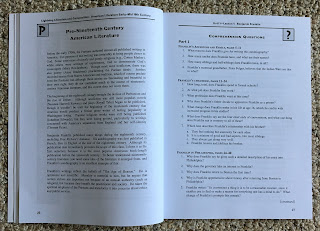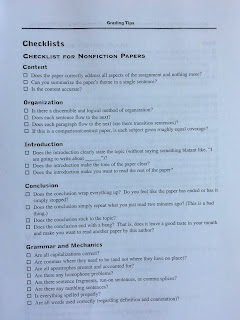I can scarcely believe it, but as of today, I am the mother of not one, but two high school students. Oh, my word. As homeschoolers, the switch from the elementary grades to the upper levels are not terribly dramatic, with the possible exception of the adolescent mood swings, he he he. Still, there are changes as it relates to curriculum. School work and assignments transition to a more independent style as students grow in competence and maturity. Personally, both of my daughters have long been self starters, particularly in the subjects that encompass English, Grammar, and Literature. They are strong readers, write well, and work best with an outline and schedule. That being the case, I was fairly confident that this review of American Early-Mid 19th Century from Hewitt Homeschooling Resources would fit in just fine with our learning styles and strengths.
The full name of the curriculum pieces that we received is the Lightning Lit & Comp- American Literature: Early-Mid 19th Century Student's Guide This is a softcover text , with 178 pages that are broken up into 4 units, 3 Appendices, and a Bibliography. There are extra books that are required for the course, which were not included in our set, but we did purchase The Classic Autobiography of Benjamin Franklin, and the Narrative of Frederick Douglass'. We also received the accompanying Teacher's Guide, which is a 56 page stapled paper packet. I'm going to start with an overview of the Student Guide.
As I first opened the Student guide to get an overview of the content, I was immediately impressed with the richness of the material. If I had to make a thesis statement about this curriculum, I would probably just borrow from the front cover which says, "Acquiring College-Level Composition Skills by responding to Great Literature." I was once again grateful that we made the choice to homeschool, because even as the teacher, I have the opportunity and privilege of learning all over again with my daughters. The Introduction is simply wonderful. It answers questions of why to read literature and poetry, as well as how to do it. When I write this out in so few words, I'm leaving so much out, as the Intro is so beautifully detailed. Your student is given step by step guidelines in putting together topics, outlines, paragraphs, and so on. There is help in learning how to gather and cite research. Most helpfully, they provide examples of good styles of writing versus poor styles. Students, and teachers really, will find themselves coming back to the Introduction periodically for helpful tips. I wish I had access to this information during my high school years. It would have saved me many tears.
The lessons are divided into sections.
- Introduction- this comes first, naturally. You'll get an overview of the lesson, a quick biography of the author that will be read, and so on.
- The Selection - this is the book, passage, poem, etc., that you'll be reading.
- While You Read - this is a list of questions that are suggested be kept in mind to ask yourself while reading the selection.
- Comprehension Questions - self explanatory, I believe. These test to see how well you understand the material. Questions may be fill in the blank or multiple choice.
Literary Lessons - these cover a main topic for the lesson, and are designed to teach you how to improve your reading and writing skills.
- Writing Exercises - this is a list of possible writing activities that relate to what was just read. It is strongly encouraged that you work on at least one or two of these.
The Intro-Why should we study this?
More from the Intro...
Possible activities to enhance learning.
The beginning of a lesson, and comprehension questions.
Writing exercises that follow a lesson.
The Teacher's Guide is much smaller in comparison to the Student's, but also very helpful. There are fantastic tips for parents/teachers in learning how to grade assignments/papers, and there are even checklists and templates included for your use. I also really appreciated the Final Words section, where teachers are encouraged to look for the good in your students', and not to overcorrect. There are also a couple of different schedules for the course work, for both use as a one semester class, or as a full year course. Everything is presented for you, so you only need to follow it, and you'll be all set. There is a section at the end that includes discussion questions and project ideas that you may implement as you like. They provide a few ideas, and you only have your imagination to limit you.
Checklists help teachers grade assignments.
Another template for teachers to use in grading papers.
I could have used this curriculum with either of my teen daughters, but I ultimately settled on my incoming freshman. I figured that due to the time in the school year, her general interest and aptitude for writing, as well as the fact that my older daughter had a larger load to complete, it would be best. Forgive my run on sentence, lol. I was considering a one semester schedule, considering the review period, but as we began, I determined that a year long schedule would be better. We purchased a copy of Benjamin Franklin's autobiography, and began. My daughter has worked on this curriculum independently for the most part. We have slowed the schedule down as the reading has proved to be a bit of a challenge, even for my strong reader. She is definitely on the younger age of the high school range that this is written for, so I'm not worried. She understands the work, it has just taken a little more time work it out. I must say, she is diligent, working on this 5 days per week.
Reading with a buddy.
My teen takes notes as she first looks at the comprehension questions.
I've explained to my daughter, both of them actually, on many occasions, that like anything, there will be some books that they enjoy more than others. Once we complete our studies on Benjamin Franklin, we have other works to look forward to. We'll have the chance to study poetry and Edgar Allen Poe. We'll discover Nathaniel Hawthorne, the Moby Dick novel, and Henry Wadsworth Longfellow. Some will click, some may not, but they are all valuable as we learn. I'm certainly enjoying the journey!
Will we use this as we begin our next school year? Yes! This is an excellent curriculum. I love the way that it provides such effective instruction in learning to write. It presents the lessons in the way that I have wanted to teach my daughters, but didn't necessarily know how to communicate. I will have both of my teens working on this come Fall. As you begin to plan your courses for next year, consider Hewitt Homeschooling Resources as an option.












No comments:
Post a Comment